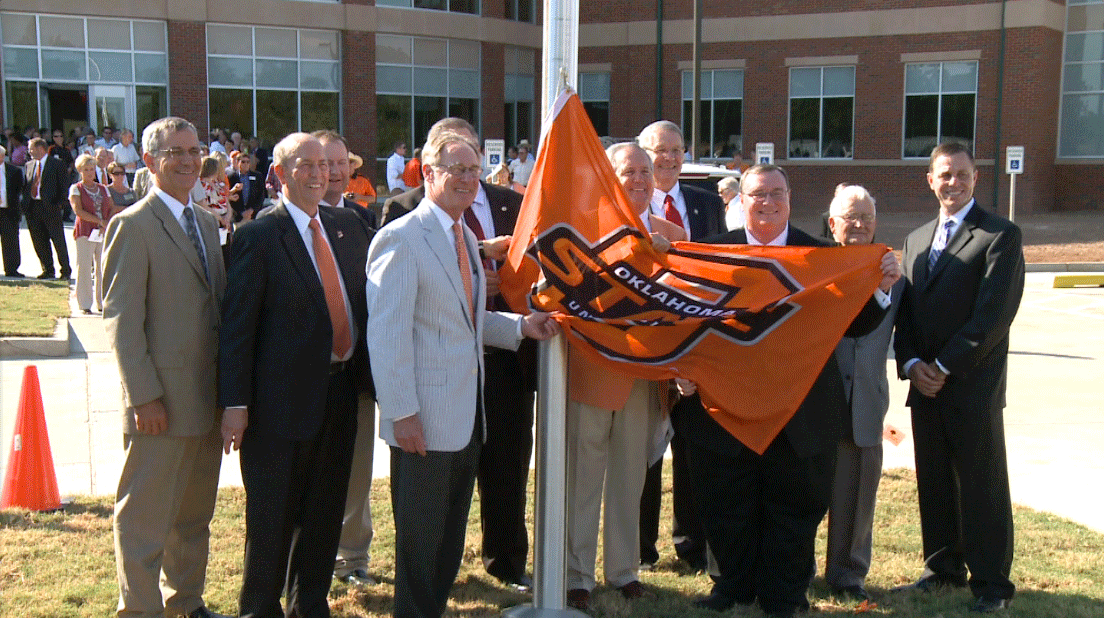New OSU Institute for Agricultural Biosciences to fuel enhanced opportunities
Friday, July 29, 2011
Please click here to see the video from the ceremony.
The development of agricultural and bioenergy advances will be getting a high-octane boost, thanks to the new $15 million Oklahoma State University Institute for Agricultural Biosciences in Ardmore.
Oklahoma civic, commodity and government leaders joined OSU President Burns Hargis and members of the Board of Regents for Oklahoma Agricultural and Mechanical Colleges, the Samuel Roberts Noble Foundation and OSU’s Division of Agricultural Sciences and Natural Resources (DASNR) for the official dedication and flag-raising on July 28.
“The institute will be a wonderful asset for Oklahoma and supports OSU’s historic land-grant mission of teaching, research and extension,” Hargis said. “It will be a key part of our efforts to enhance state and regional agricultural and energy interests, and strengthens our partnership with the Noble Foundation, which has been an ongoing collaboration since 1951.”
Located at the corner of Mary Niblack Road and Sam Noble Parkway on State Highway 199, east of Ardmore, the institute is a 33,000 sq. ft. facility designed to enable scientists to solve challenges related to cellular and plant biology, plant and animal sciences, and biomass development for bioenergy. It includes a multimedia auditorium that seats 100 individuals, two conference rooms, two team meeting rooms, offices and state-of-the-art laboratories.
Robert E. Whitson, DASNR vice president, dean and director, said the institute will strengthen and enhance programs associated with all three aspects of the division: the College of Agricultural Sciences and Natural Resources and the division’s two state agencies, the Oklahoma Agricultural Experiment Station system and the Oklahoma Cooperative Extension Service.
“The institute will assist state and regional agricultural producers through the creation of new or improved crops and cropping systems that also will enhance livestock production,” Whitson said. “It will foster development of new, viable alternatives for rural economies through technology transfer, moving science-based discoveries and advances from the laboratory and research settings into the marketplace.”
On-site activities will be enhanced through collaboration with other OSU units, such as the Department of Animal Science and College of Veterinary Medicine relative to livestock production and the Biobased Products and Energy Center in developing techniques to efficiently convert biomass into usable forms of energy.
In addition, OSU graduate and undergraduate students will have enhanced opportunities to train with some of the most prestigious researchers within the division and Noble Foundation, many of whom are world-renowned in their career fields.
For Martin Dyer, who during his tenure as mayor of Ardmore was instrumental in helping acquire the land for the institute, the dedication and flag-raising signal the start of something great for Ardmore, Carter County and surrounding counties.
“Given the historic and continuing research accomplishments of OSU and the Noble Foundation, I can envision Ardmore becoming known throughout the United States as a center of cutting-edge scientific advancement and technology development,” he said.
In addition to direct benefits from the development of new and improved products and best management practices, Dyer believes the institute’s presence will help showcase Ardmore as a community on the rise.
“Having such a high-profile and important facility in Ardmore strengthens our ability to improve local services and promote economic development, not just in the city but across the county and region,” he said.
Point in fact: The facility itself is a physical testament to wise use of resources. The building is certified as meeting Leadership in Energy and Environmental Design (LEED) criteria, which means it adheres to high-performance standards for sustainability, water efficiency, energy and atmosphere, materials and resources, and environmental quality.
“The institute is OSU’s first LEED facility, and other universities, organizations and agencies will be looking at Ardmore and the facility as an example of how construction of similar buildings should be done,” Whitson said.
Being an LEED-certified building is projected to save $18 in energy and operational costs for each $1 invested, resulting in approximately $12 million in projected savings during the next 40 years.
Whitson said the institute has a projected annual budget of $1 million to $5 million, depending on external competitive research funding.
The Oklahoma A&M Board of Regents approved construction procedures on Oct. 27, 2006. The Oklahoma Legislature made an appropriation of $10 million to fund the new institute. Construction began in April 2009.

